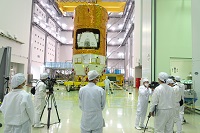This is an archive of information released in the past.
Disclaimer: It may contain broken links or outdated information. Some parts may not function in current web browsers.
*Visit https://humans-in-space.jaxa.jp/en/ for the latest information.

ISS/Kibo Monthly News
ISS/Kibo Monthly News: October - November, 2016
Topic of the Month
Astronaut Takuya Onishi undergoing rehabilitation after returning to Earth

Onishi just after landing (October 30. Credit: JAXA/NASA/Bill Ingalls)
Astronaut Takuya Onishi, who landed on Earth on October 30, has returned to Ellington Airport near the NASA Johnson Space Center in the wee hours of the next day.
Onishi underwent a simple medical checkup and motor function test, and then began full-fledged rehabilitation the next day. Thanks to the exercise Onishi underwent almost every day on orbit, his muscles and bone density showed little deterioration. His rehabilitation thus focuses on recovering a sense of balance.
On the fifth day of his rehabilitation, Onishi wrote in his Google+ that the motions he felt difficult to do may be similar to those that elderly people experience. On the ninth day, Onishi started running on a dedicated treadmill created by NASA for rehabilitation that generates air pressure to alleviate strain on such joints as the knees.

Onishi undergoing motor function test after returning to Houston (October 31. Credit: JAXA/Takuya Onishi)
KOUNOTORI6 and CubeSats unveiled to the media
On October 19, the H-II Transfer Vehicle KOUNOTORI6 (HTV6) was opened to the media and a briefing session for the mission was held at the Tanegashima Space Center (TNSC).
The payload of KOUNOTORI6, the improvements made to KOUNOTORI6, and delivery of the new ISS batteries were explained.
On November 7, seven microsatellites (CubeSats) and the upgraded CubeSat deployer (JEM Small Satellite Orbital Deployer: J-SSOD) with double the deployment capacity, both of which will be delivered aboard KOUNOTORI6, were also unveiled to the media.
The number of deployments from the J-SSOD during one mission term will be the largest ever. JAXA has been and will be enhancing the deployment capacity in response to the growing demand for CubeSat deployment.
KOUNOTORI6 is scheduled for launch on December 9, at 10:26 p.m.
Results of Onishi's mission
Return of the protein crystal samples and initial microscopic results
High Quality Protein Crystal Growth (JAXA PCG) research is one of Japan's specialty experiments.
The protein samples that were carried to the ISS on October 19 aboard the Soyuz spacecraft (48S) underwent a short-term experiment of about 10 days, and then were returned to Earth with Astronaut Onishi on October 30.
On November 2, immediately after being returned from Russia to Japan, the samples were viewed under a microscope to determine their condition. About 60% of the samples were admitted as being bearable for detailed analysis.

Protein crystals obtained in space
These obtained samples will be handed over to researchers for analysis at synchrotron radiation facilities (such as SPring-8).
One recent achievement of this experiment is seen in the successful collaborative experiment conducted between JAXA and Chuo University that involved the synthesis and structural analysis of artificial blood for dogs.
Capture of the Cygnus spacecraft
The Cygnus spacecraft (Orbital ATK CRS-5 or OA-5) was launched on October 18 with system hardware, experiment equipment, food, and other supplies for the onboard crew.
Onishi maneuvered the Space Station Remote Manipulator System (SSRMS) and became the first Japanese astronaut to capture the Cygnus spacecraft in space.
Later, the ground team maneuvered the SSRMS to transfer the Cygnus spacecraft and then berthed it to the Unity (Node 1) module.
Preparation for the combustion experiment
In Kibo, preparations have been completed for the combustion experiment.
The experiment titled "Elucidation of Flame Spread and Group Combustion Excitation Mechanism of Randomly-distributed Droplet Clouds (Group Combustion)" will be the first combustion experiment to be conducted in Kibo. Onishi placed the Group Combustion Experiment Module (GCEM) into the Chamber for Combustion Experiment (CCE), and then installed it in the Multi-purpose Small Payload Rack (MSPR). Later he performed the leak check.
Initial checkout of the Electrostatic Levitation Furnace (ELF)
The Electrostatic Levitation Furnace (ELF) enables the acquisition of the high-precision thermophysical properties of materials with high-melting points (e.g. 3,000℃). In the ELF, sample materials are levitated using electrostatic force and then melted by laser, in order to study their physical properties, such as viscosity, density and surface tension.
Onishi prepared for the initial checkout and exchanged sample cartridges.
Kibo this month
CALET data supports the finding of LIGO
The CALorimetric Electron Telescope (CALET) that has been attached to the Exposed Facility (EF) of Kibo supported the finding of the Laser Interferometer Gravitational-Wave Observatory (LIGO) of the United States. At the time, LIGO detected gravitational waves, but CALET didn't detect X-rays or gamma rays. Therefore, as speculated, the data of CALET confirmed that the gravitational waves detected were derived from the merger of a pair of black holes.
Receipt of samples from Turkey for the exposed experiment

Astronaut and JAXA ISS program manager Koichi Wakata receives samples at the TKSC (November 2)
In September, JAXA and the Republic of Turkey signed a new cooperation arrangement concerning the utilization of Kibo for deploying a microsatellite (CubeSat) from the Kibo module and conducting material experiments in an exposed environment using the Exposed Experiment Handrail Attachment Mechanism (ExHAM) attached to Kibo's EF.
| Copyright 2007 Japan Aerospace Exploration Agency | Site Policy |






